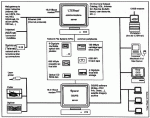The Long-Term Ecological Research Network’s mail forwarding system has been undergoing a major upgrade with new funding from the National Science Foundation (‘Remote Sensing Data Acquisition and Connectivity Initiative for the LTER Network,” Franklin, Vande Castle, Nottrott). The current system, “LTERNET.washington.edu”, has been running on a relatively small VAXstation-2000 which has continuously been expanded with various mail system interface protocols to allow direct communication to the diverse systems used by LTER. These include the Land- Margin Ecosystem Research Program, U.S. DOE Parknet, NASA, NOAA, EPA, and the USDA Forest Service. Computer services will be expanded from mail forwarding to include an on-line bulletin board, storage, database access, remote file sharing, dial-up access, on-line archival storage.
The two systems will share an extensive pool of hardware and software resources in a unified environment along with more than 4 gigabytes (Gb) of hard disk storage. A 6Gb removable, rewritable optical disk jukebox will provide on-line archival storage and backup capability. They will also share two CD-ROM drives, a 600Mb optical disk, 150Mb SUN cartridge tape drive, a Cipher 300-6250 BPI tape drive, and two 19.2kbaud modems.
The complete system will be configured with an X.25 communications link for access to U.S. SPRINTnet services. With this capability, any LTER researcher will be able to access LTERNET, or a local host machine, through a local- dial phone connection. Existing Internet connections will also allow LTER sites direct access via Network File System (NFS) services. Using NFS protocols, file systems at the Network Office can be directly connected to any site’s PC, workstation or mainframe.
The existing LTERNET VAX will be renamed and used for VAX network services. Two satellite systems, an 80386 PC running VPIX (DOS) under Unix and a MacIntosh -Ilci, will also be integrated into the network to provide links for DOS and MacIntosh systems.
by John Vande Castle and Rudolf Nottrou

 Enlarge this image
Enlarge this image